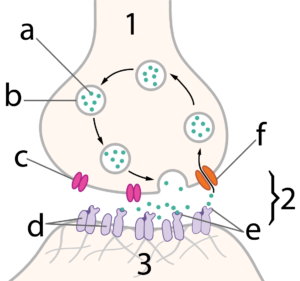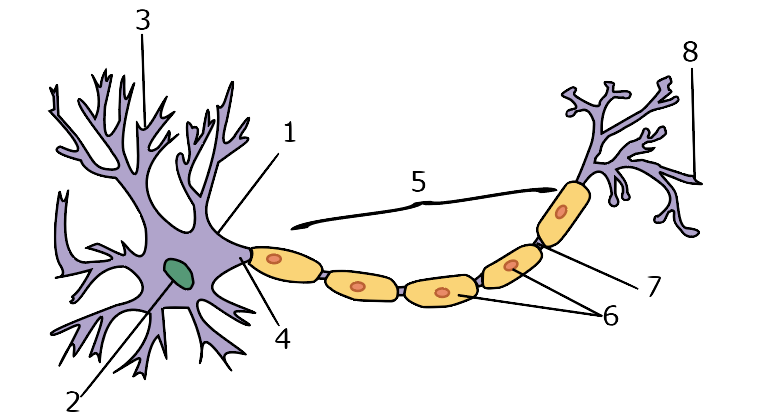1. Introduction
[qwiz]
[h]Review of reflexes, introduction to synapses
[q labels = “top”]
At this point, you should have a pretty good understanding of how information about an injury makes its way from a burning finger (shown at number ___) to the spinal cord (at number ___). There, information has to be passed from a sensory neuron (___), to a motor neuron (___), Some reflex arcs might also include an ____________ (not shown).
To pass between neurons, nerve impulses have to cross a __________. To do so, the ___________ neuron will release a ______________ from the tip of its _______. When the neurotransmitter binds with a ________ at the postsynaptic __________, a new ______ potential might be initiated.
Let’s see how.
[l]1
[fx] No. Please try again.
[f*] Correct!
[l]2
[fx] No. Please try again.
[f*] Correct!
[l]3
[fx] No, that’s not correct. Please try again.
[f*] Correct!
[l]4
[fx] No. Please try again.
[f*] Excellent!
[l]5
[fx] No, that’s not correct. Please try again.
[f*] Excellent!
[l]6
[fx] No. Please try again.
[f*] Great!
[l]7
[fx] No. Please try again.
[f*] Good!
[l]action
[fx] No, that’s not correct. Please try again.
[f*] Good!
[l]axon
[fx] No, that’s not correct. Please try again.
[f*] Excellent!
[l]dendrite
[fx] No. Please try again.
[f*] Excellent!
[l]interneuron
[fx] No. Please try again.
[f*] Good!
[l]presynaptic
[fx] No. Please try again.
[f*] Good!
[l]synapse
[fx] No. Please try again.
[f*] Great!
[l]neurotransmitter
[fx] No, that’s not correct. Please try again.
[f*] Correct!
[l]receptor
[fx] No. Please try again.
[f*] Good!
[/qwiz]
2. Synapses

The tip of the post-synaptic axon (1) contains vesicles (b) that are filled with neurotransmitter (a).
When an action potential arrives at the tip of the axon, the subsequent changes in membrane potential cause voltage-sensitive calcium ion channels (c) to open. This allows calcium ions (not shown) to diffuse into the tip of the axon, causing cytoplasmic changes that induce exocytosis: the vesicles fuse with the tip of the axonal membrane, releasing their contents into the the synaptic cleft (2), which is the space between the pre-synaptic axon and the post-synaptic dendrite (3).
These vesicles (and the neurotransmitter they contain) are formed as part of the endomembrane system (the system that includes ribosomes, the endoplasmic reticulum, the Golgi complex, etc). Click here to open a tab to review how that system works.
Once released, the neurotransmitter passively diffuses across the synaptic cleft. On the tips of the dendrites on the postsynaptic cell, ligand-gated ion channels (d) have receptors (e) that are complementary to (and can specifically bind with) the neurotransmitter. When the neurotransmitter binds with these receptors, the channels change shape. If these channels are sodium ion channels, the result will be a graded depolarization of the membrane (making an action potential in the postsynaptic cell more likely). If they’re potassium ion channels, they’ll cause a hyperpolarization, and make the action potential less likely.
The binding between the neurotransmitter and the receptor is a weak and temporary bond. After a few moments of binding, the neurotransmitters break away from the receptor, and diffuse back into the synaptic cleft. The cleft may contain enzymes (not shown) that degrade the neurotransmitter. Alternatively, the neurotransmitter may be taken up by reuptake channels (f) in the presynaptic cell, allowing the neurotransmitter to be repackaged and reused.
[qwiz random = “true” qrecord_id=”sciencemusicvideosMeister1961-Synapses, M28″]
[h]The Synapse
[i]
[q]Label the following events in the sequence with which they occur.
- _______: Action potential arrives at the end of an axon
- _______: Neurotransmitter binds with receptors on ligand-gated ion channels.
- _______: Neurotransmitter diffuses across the synaptic cleft
- _______: Post-synaptic channels allow ions to diffuse through.
- _______: Vesicles with neurotransmitter fuse with axonal membrane
- _______: Voltage sensitive calcium ion channels open
[l]First
[fx] No. Please try again.
[f*] Correct!
[l]Second
[fx] No. Please try again.
[f*] Good!
[l]Third
[fx] No, that’s not correct. Please try again.
[f*] Great!
[l]Fourth
[fx] No, that’s not correct. Please try again.
[f*] Correct!
[l]Fifth
[fx] No, that’s not correct. Please try again.
[f*] Excellent!
[l]Sixth
[fx] No, that’s not correct. Please try again.
[f*] Good!
[q]Which of the following represents the synaptic cleft?
[textentry single_char=”true”]
[c]Mg ==[Qq]
[f]WWVzLiAyIGlzIHRoZSBzeW5hcHRpYyBjbGVmdC4=[Qq]
[c]Kg==[Qq]
[f]Tm8uIFRoZSBzeW5hcHRpYyBjbGVmdCBpcyB0aGUgc3BhY2UgYmV0d2VlbiB0aGUgcHJlc3luYXB0aWMgYXhvbiBhbmQgdGhlIHBvc3RzeW5hcHRpYyBkZW5kcml0ZS4=[Qq]
[q]Which of the following represents a vesicle containing neurotransmitter?
[textentry single_char=”true”]
[c]Yg ==[Qq]
[f]WWVzLiBMZXR0ZXIgYiBpcyBhIHZlc2ljbGUgY29udGFpbmluZyBuZXVyb3RyYW5zbWl0dGVyLg==[Qq]
[c]Kg==[Qq]
[f]Tm8uIEhlcmUmIzgyMTc7cyBhIGhpbnQ6IHRoZSB2ZXNpY2xlIGlzIGhvbGRpbmcgdGhlIG5ldXJvdHJhbnNtaXR0ZXIgdGhhdCB3aWxsIGJlIHJlbGVhc2VkIGludG8gdGhlIHN5bmFwdGljIGNsZWZ0LiBGaWd1cmUgb3V0IHdoYXQmIzgyMTc7cyBiZWluZyByZWxlYXNlZCBpbnRvIHRoZSBjbGVmdCwgYW5kIHdvcmsgYmFja3dhcmRzIGZyb20gdGhlcmUu[Qq]
[q]Which of the following represents neurotransmitter?
[textentry single_char=”true”]
[c]YQ ==[Qq]
[f]WWVzLiBMZXR0ZXIgJiM4MjIwO2EmIzgyMjE7IHJlcHJlc2VudHMgbmV1cm90cmFuc21pdHRlci4=[Qq]
[c]Kg==[Qq]
[f]Tm8uIEhlcmUmIzgyMTc7cyBhIGhpbnQ6IHRoZSBuZXVyb3RyYW5zbWl0dGVyIHdpbGwgYmUgcmVsZWFzZWQgaW50byB0aGUgc3luYXB0aWMgY2xlZnQgKHJlZ2lvbiAyKS4=[Qq]
[q]Which of the following represents a voltage-gated calcium channel?
[textentry single_char=”true”]
[c]Yw ==[Qq]
[f]WWVzLiBMZXR0ZXIgJiM4MjIwO2MmIzgyMjE7IHJlcHJlc2VudHMgdm9sdGFnZS1nYXRlZCBjYWxjaXVtIGNoYW5uZWwu[Qq]
[c]Kg==[Qq]
[f]Tm8uIEhlcmUmIzgyMTc7cyBhIGhpbnQ6IGl0JiM4MjE3O3Mgb24gdGhlIHByZXN5bmFwdGljIGF4b24sIGFuZCBpdCYjODIxNztzIG5vdCAmIzgyMjA7Zi4mIzgyMjE7[Qq]
[q]Which of the following represents a ligand-gated ion channel?
[textentry single_char=”true”]
[c]ZA ==[Qq]
[f]WWVzLiBMZXR0ZXIgJiM4MjIwO2QmIzgyMjE7IHJlcHJlc2VudHMgYSBsaWdhbmQtZ2F0ZWQgaW9uIGNoYW5uZWwu[Qq]
[c]Kg==[Qq]
[f]Tm8uIEhlcmUmIzgyMTc7cyBhIGhpbnQ6IGl0JiM4MjE3O3Mgb24gdGhlIHBvc3RzeW5hcHRpYyBkZW5kcml0ZS4=[Qq]
[q]Which of the following represents the receptor on the ligand-gated ion channel?
[textentry single_char=”true”]
[c]ZQ ==[Qq]
[f]WWVzLiBMZXR0ZXIgJiM4MjIwO2UmIzgyMjE7IHJlcHJlc2VudHMgYSByZWNlcHRvciBvbiBhIGxpZ2FuZC1nYXRlZCBpb24gY2hhbm5lbC4=[Qq]
[c]Kg==[Qq]
[f]Tm8uIEhlcmUmIzgyMTc7cyBhIGhpbnQ6IGl0JiM4MjE3O3MgcGFydCBvZiB0aGUgY2hhbm5lbCB0aGF0JiM4MjE3O3Mgb24gdGhlIHBvc3RzeW5hcHRpYyBkZW5kcml0ZSAod2hpY2ggaXMgMyku[Qq]
[q]Which of the following represents a neurotransmitter reuptake channel?
[textentry single_char=”true”]
[c]Zg ==[Qq]
[f]WWVzLiBMZXR0ZXIgJiM4MjIwO2YmIzgyMjE7IHJlcHJlc2VudHMgYSBuZXVyb3RyYW5zbWl0dGVyIHJldXB0YWtlIGNoYW5uZWw/[Qq]
[c]Kg==[Qq]
[f]Tm8uIEhlcmUmIzgyMTc7cyBhIGhpbnQ6IGl0JiM4MjE3O3Mgb24gdGhlIHByZXN5bmFwdGljIGF4b24gKHdoaWNoIGlzIG51bWJlciAxKS4=[Qq]
[q]When this opens, a depolarization or a hyperpolarization could result.
[textentry single_char=”true”]
[c]ZA ==[Qq]
[f]WWVzLiBMZXR0ZXIgJiM4MjIwO2QmIzgyMjE7IHJlcHJlc2VudHMgYSBsaWdhbmQtZ2F0ZWQgaW9uIGNoYW5uZWwuIElmIGl0JiM4MjE3O3MgZm9yIHNvZGl1bSBpb25zLCBpdHMgb3BlbmluZyB3aWxsIGNhdXNlIGEgZGVwb2xhcml6YXRpb24uIElmIGl0JiM4MjE3O3MgZm9yIHBvdGFzc2l1bSwgaXRzIG9wZW5pbmcgd2lsbCBjYXVzZSBhIGh5cGVycG9sYXJpemF0aW9uLg==[Qq]
[c]Kg==[Qq]
[f]Tm8uIEhlcmUmIzgyMTc7cyBhIGhpbnQ6IGl0JiM4MjE3O3Mgb24gdGhlIHBvc3RzeW5hcHRpYyBkZW5kcml0ZS4=[Qq]
[q]Which letter or number below represents a vesicle full of neurotransmitter?
[textentry single_char=”true”]
[c]YQ ==[Qq]
[f]WWVzLiBMZXR0ZXIgJiM4MjIwO2EmIzgyMjE7IHJlcHJlc2VudHMgYSB2ZXNpY2xlIGZ1bGwgb2YgbmV1cm90cmFuc21pdHRlci4=[Qq]
[c]Kg==[Qq]
[f]Tm8uIEhlcmUmIzgyMTc7cyBhIGhpbnQ6IGl0JiM4MjE3O3MgcGFydCBvZiB0aGUgcHJlc3luYXB0aWMgbmV1cm9uLg==[Qq]
[q] A ligand-gated ion channel.
[textentry single_char=”true”]
[c]ZA ==[Qq]
[f]WWVzLiBMZXR0ZXIgJiM4MjIwO2QmIzgyMjE7IHJlcHJlc2VudHMgYSBsaWdhbmQtZ2F0ZWQgaW9uIGNoYW5uZWwu[Qq]
[c]Kg==[Qq]
[f]Tm8uIEhlcmUmIzgyMTc7cyBhIGhpbnQ6IGl0JiM4MjE3O3MgcGFydCBvZiB0aGUgcG9zdHN5bmFwdGljIG5ldXJvbi4=[Qq]
[q] A neurotransmitter reuptake channel.
[textentry single_char=”true”]
[c]Zg ==[Qq]
[f]WWVzLiBMZXR0ZXIgJiM4MjIwO2YmIzgyMjE7IHJlcHJlc2VudHMgYSBuZXVyb3RyYW5zbWl0dGVyIHJldXB0YWtlIGNoYW5uZWwu[Qq]
[c]Kg==[Qq]
[f]Tm8uIEhlcmUmIzgyMTc7cyBhIGhpbnQ6IGl0JiM4MjE3O3MgcGFydCBvZiB0aGUgcHJlc3luYXB0aWMgbmV1cm9uLg==[Qq]
[/qwiz]
3. Summation
Neurons are biological computers. They can take multiple inputs, process them, and compute an output. Taken together, this computational process is called summation, which means “adding up” (just note the root word, “sum,” and you won’t forget it).
 In terms of summation, the key part of the cell is the axon hillock (4), the region where the axon branches off from the cell body. Complete the interactive reading below about the effect of neurotransmitters on postsynaptic cells, and then we’ll look at the details of how summation works.
In terms of summation, the key part of the cell is the axon hillock (4), the region where the axon branches off from the cell body. Complete the interactive reading below about the effect of neurotransmitters on postsynaptic cells, and then we’ll look at the details of how summation works.
[qwiz]
[h]Effects of neurotransmitters
[q labels = “left”]As stated above, the effect of a neurotransmitter on the membrane potential in the postsynaptic cell depends on which type of ligand-gated ion channels are being opened.
In the diagram at left, the resting potential is shown at ____, at about ______ mV, and the threshold potential is shown at _____, at about ______ mV. If a neurotransmitter binds with a ligand-gated sodium channel, the effect will be a _____________, shown at _____. If the a neurotransmitter binds with a a ligand-gated potassium channel, the effect will be a ________________, shown at ______.
While a depolarization makes an action potential ______ likely, a hyperpolarization makes it _______ likely.
[l]A
[fx] No, that’s not correct. Please try again.
[f*] Excellent!
[l]B
[fx] No. Please try again.
[f*] Good!
[l]C
[fx] No. Please try again.
[f*] Correct!
[l]D
[fx] No, that’s not correct. Please try again.
[f*] Correct!
[l]-50
[fx] No. Please try again.
[f*] Great!
[l]-70
[fx] No, that’s not correct. Please try again.
[f*] Correct!
[l]depolarization
[fx] No, that’s not correct. Please try again.
[f*] Correct!
[l]hyperpolarization
[fx] No, that’s not correct. Please try again.
[f*] Good!
[l]less
[fx] No. Please try again.
[f*] Good!
[l]more
[fx] No, that’s not correct. Please try again.
[f*] Correct!
[/qwiz]
Hyperpolarizations, because they make action potentials less likely, are called inhibitory postsynaptic potentials, or IPSPs. Depolarizations, which make action potentials more likely, are called excitatory postsynaptic potentials, or EPSPs.
 Summation is about adding up EPSPs and IPSPs in a way that determines whether an action potential is initiated at the axon hillock (number 3 in the diagram to your left).
Summation is about adding up EPSPs and IPSPs in a way that determines whether an action potential is initiated at the axon hillock (number 3 in the diagram to your left).
In diagram A, a single axon (2) is synapsing with a postsynaptic neuron (1). The axon delivers two graded depolarizations in succession (represented by the two depolarizations at 4). Because of the interval between the two depolarizations, the membrane repolarizes, and returns to its resting potential. The threshold potential is never reached (and no action potential occurs at the axon hillock)
The difference between A and B is in the interval between the two depolarizations. In B, they come in quick succession, so they have a cumulative effect, and the depolarization reaches the threshold potential. The result is the action potential (6).
In both diagrams A and B, the key variable was the timing of the impulse from a single presynaptic axon. When stimuli that arrive at different times are added together, the effect is called temporal summation. If you know French, think of temps, which means time; in Spanish, temporada means season; if you know biology, think of temporal isolation (which is a type of prezygotic reproductive barrier between species).
In diagram C, two axons are converging on a single postsynaptic cell. In this case the summation is spatial, and you can see how these two simultaneous graded depolarizations add up to a sufficient level to exceed the threshold, and initiate an action potential.
In D (like C) two axons converge on the postsynaptic cell. In this case, however, one axon generates an IPSP, while the second generates an EPSP. The effect of the two together is to keep the membrane potential at the axon hillock below the threshold, and no action potential results.
Got it? Take the quiz below.
[qwiz random = “true” qrecord_id=”sciencemusicvideosMeister1961-Summation, M28″]
[h]Summation
[i]
[q labels = “top”]
[l]temporal summation
[fx] No, that’s not correct. Please try again.
[f*] Correct!
[l]spatial summation
[fx] No. Please try again.
[f*] Great!
[q labels = “top”]
In the diagram at right
A is a(n) _______
B is a(n) _______
C is a(n) ________.
A and B together: __________ summation that’s sufficient to create an an _______ potential.
[l]action
[fx] No, that’s not correct. Please try again.
[f*] Great!
[l]IPSP
[fx] No, that’s not correct. Please try again.
[f*] Good!
[l]EPSP
[fx] No, that’s not correct. Please try again.
[f*] Great!
[l]spatial
[fx] No. Please try again.
[f*] Great!
[l]temporal
[fx] No. Please try again.
[f*] Correct!
[q labels = “top”]
[l]spatial summation
[fx] No. Please try again.
[f*] Good!
[l]temporal summation
[fx] No, that’s not correct. Please try again.
[f*] Correct!
[q labels = “top”]
[l]IPSP
[fx] No. Please try again.
[f*] Good!
[l]EPSP
[fx] No. Please try again.
[f*] Good!
[q]In the diagram below, which number represents temporal summation?
[textentry single_char=”true”]
[c]NA ==[Qq]
[f]WWVzLiA0IHJlcHJlc2VudHMgdGVtcG9yYWwgc3VtbWF0aW9uLg==[Qq]
[c]Kg==[Qq]
[f]Tm8uIEZpbmQgdGhlIHBhcnQgb2YgdGhlIGdyYXBoIHdoZXJlIHR3byBzdGltdWxpIHNlZW0gdG8gYmUgYWRkZWQgdG9nZXRoZXIu[Qq]
[q]In the diagram below, which number represents the threshold potential.
[textentry single_char=”true”]
[c]Mg ==[Qq]
[f]WWVzLiAyIHJlcHJlc2VudHMgdGhlIHRocmVzaG9sZCBwb3RlbnRpYWwu[Qq]
[c]Kg==[Qq]
[f]Tm8uIFlvdSYjODIxNztyZSBsb29raW5nIGZvciB0aGUgdm9sdGFnZSBhYm92ZSB3aGljaCBhbiBhY3Rpb24gcG90ZW50aWFsIHN0YXJ0cy4=[Qq]
[q]In the diagram below, which number represents the action potential?
[textentry single_char=”true”]
[c]NQ ==[Qq]
[f]WWVzLiA1IHJlcHJlc2VudHMgYW4gYWN0aW9uIHBvdGVudGlhbC4=[Qq]
[c]Kg==[Qq]
[f]Tm8uIEFuIGFjdGlvbiBwb3RlbnRpYWwgaXMgYSBkZXBvbGFyaXphdGlvbiB0aGF0IG1vdmVzIHRoZSBtZW1icmFuZSYjODIxNztzIHBvdGVudGlhbCBmcm9tIGl0cyBuZWdhdGl2ZSByZXN0aW5nIHBvdGVudGlhbCB0byBhIHBvc2l0aXZlIHZhbHVlLg==[Qq]
[q]In the diagram below, which number represents EPSPs that don’t reach the threshold?
[textentry single_char=”true”]
[c]Mw ==[Qq]
[f]WWVzLiAzIHJlcHJlc2VudHMgdHdvIEVQU1BzIHRoYXQgZG9uJiM4MjE3O3QgcmVhY2ggdGhlIHRocmVzaG9sZC4=[Qq]
[c]Kg==[Qq]
[f]Tm8uIEZpbmQgdGhlIGRlcG9sYXJpemF0aW9ucyB0aGF0IGFyZSBpbnN1ZmZpY2llbnQgZm9yIGdlbmVyYXRpbmcgYW4gYWN0aW9uIHBvdGVudGlhbC4=[Qq]
[q]In the diagram below, which number represents the moment when voltage-gated ion channels are opening?
[textentry single_char=”true”]
[c]NQ ==[Qq]
[f]WWVzLiBEdXJpbmcgYW4gYWN0aW9uIHBvdGVudGlhbCwgdm9sdGFnZS1nYXRlZCBpb24gY2hhbm5lbHMgb3BlbiB1cC4=[Qq]
[c]Kg==[Qq]
[f]Tm8uIEhlcmUmIzgyMTc7cyBhIGhpbnQ6IFZvbHRhZ2UgZ2F0ZWQgaW9uIGNoYW5uZWxzIG9wZW4gdXAgZHVyaW5nIGFjdGlvbiBwb3RlbnRpYWxzLg==[Qq]
[x][restart]
[/qwiz]
4. What’s Next?
You could spend an entire lifetime studying about the nervous system, but for us, that’s going to do it. Click the cumulative assessment link below to make sure you’ve mastered what you need to know for your biology course.
Links
